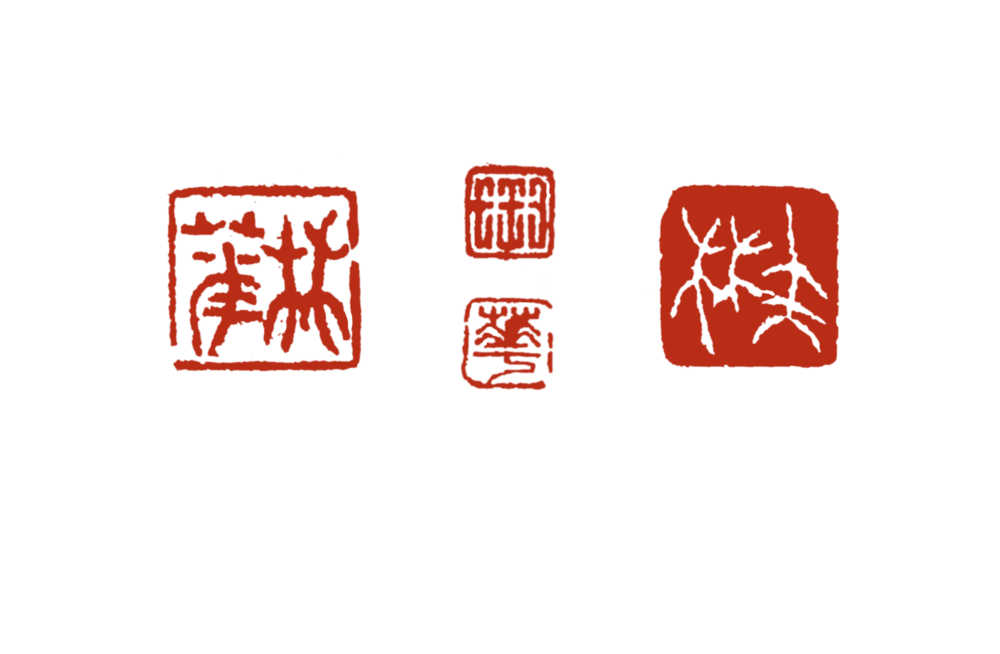"Sumi" ink
...is made from burning certain kinds of wood or oil to produce soot. Originally the soot was scraped off the sides of kilns which were used for making ceramics. Today the soot is collected from glass or ceramic dishes. Soot is compressed with animal glue to create an ink stick which is then aged. Burning different woods or oils produces different black colors with tinges of brown, blue or pure black. The goal of painting with sumi ink is to create paintings which, although in black and white, appear to be in color. The ink, mixed with varying amounts of water, produce lines and forms which vary from deepest black to silvery gray. Knowing how to control the “color” of the ink is crucial for producing a satisfying painting.
Ink stone or "suzuri"
These are usually made of natural stone but can also be made of ceramic. The stone must be porous, with a smooth surface for grinding. Some natural stones, such as "duan" stone, make outstanding and very valuable ink-stones that produce excellent ink when the ink-stick is ground with water on the flat surface of the ink stone. Stones are often valued for the type of rare stone used, and/or the carving which adorns them. Usually a stone used to prepare ink for calligraphy has a deep well, while the well on stones used for painting is much shallower. Calligraphy uses more ink than painting. Grinding the ink is a meditative process, taking anywhere from 5 minutes to 30 minutes. The process of grinding the ink stick in water against the ink-stone warms up the muscles of the hand and arm so it will be ready for the physical act of painting with the whole body. Since painting requires absolute attention, the process of grinding also allows the painter to begin to separate from the everyday world, focusing the mind, relaxing and contemplating what is to be painted that day.
Brush
Once the ink-stick has been ground with water on the stone to create a dense black viscous liquid, it is applied to the paper with a brush. Both the sumi-ink painting brush and the calligraphy brush consist of a long, usually bamboo, handle and different kinds of animal hair. The hair is arranged in a circle extending from the end of the handle, and comes to a point. With painting brushes, often there are 2 or 3 different kinds of hair attached concentrically and tapered, with the stiffest hair creating the point in the center. Made of all-natural hair from different kinds of animals, this brush is remarkably resilient and expressive, serving as a direct extension of the painter's arm and hand. Some painters use different sized brushes – different in thickness and in length of bristles - to achieve different types of lines. Other painters become comfortable with their favorite brush and use it much of the time, varying the line by varying the amount of water and ink used. Different kinds of brushes with different types and lengths of animal hair are used for different subjects. Flowers want a slightly softer brush, bamboo wants a springier brush, landscape wants a stiffer but highly expressive brush, washes want longer bristles, and so on. But always, the character of the line on the paper reveals the character of the painter and the quality of their state of mind.
Rice paper, sometimes also called "washi"
This is paper made from the inner parts of the rice plant, hemp, bamboo, or most commonly, the bark of the mulberry tree. It is highly fibrous and usually lightly sized on one side using alum. It is very thin, yet very strong. When sumi-ink is applied, the fibers grab the ink so that each stroke is permanent and cannot be erased or covered over. There are different thicknesses and fibrousness of paper which interact with the ink and the water in different ways to produce varying effects. Fine line painting prefers sized paper; landscape painting with its washes prefers less sized paper made from longer fibers that can hold more water without breaking down. Because the paper is highly fibrous and reactive, once the ink is laid down in a stroke, it cannot be erased or painted over. The less experienced painter is often highly tentative, worrying about making mistakes. The more experienced and more highly trained painter has confidence, moving the loaded brush along the paper with energy. The partnership between painter and paper mediated by ink-loaded brush makes for a lively and energized painting which doesn’t have to be perfect in order to be deeply expressive and satisfying.
